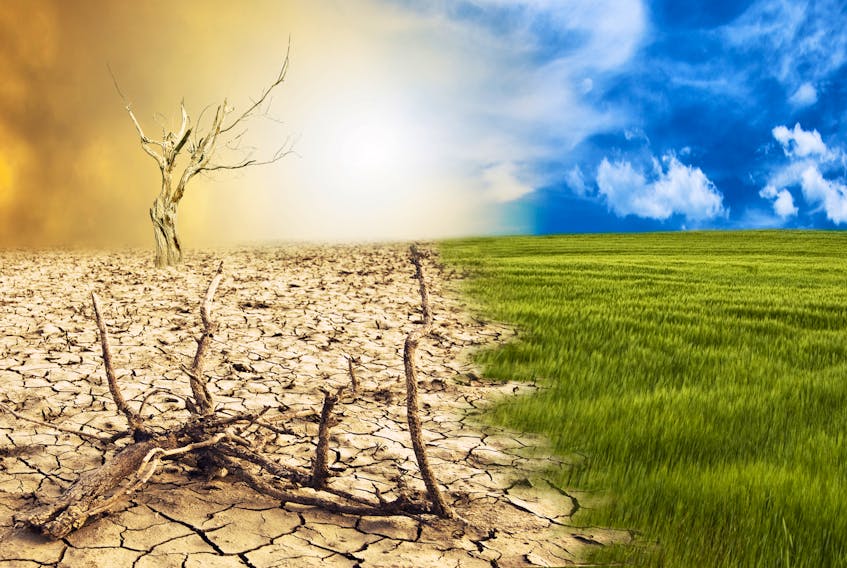The impact of COVID-19 has been so total that it’s hard to remember that the world isn’t literally standing still.
As countries begin to crack open the doors of society and peek out into the COVID-19 world, it’s natural to wonder what kind of impact the near-simultaneous reduction in activity has had on the natural world.
The answer, at least in the long term, appears to be “not much.”
“In terms of the restrictions in response to COVID, they have reduced emissions,” says Nathan Gillett, a climate scientist from British Columbia who is one of the lead authors on the most recent International Panel on Climate Change (IPCC) report, as well as a lead author on Canada’s Changing Climate Report (CCCR) that came out this past April.
“The best estimates published so far indicate a reduction in carbon dioxide emissions this year of around eight per cent compared to the previous year.”

While an eight per cent drop is significant, it comes in response to a drastic shift in the way we live and is therefore not likely sustainable. We’ve spent decades dumping carbon into the atmosphere, he says; a few months’ of reductions aren’t going to undo those decades.
“In terms of the effect of carbon dioxide on the climate, it’s the cumulative emissions over time that drive the global warming response,” says Gillett.
“I heard someone else make the analogy that the climate effect is like you're piling up a tower of blocks and you're adding a block to the tower each year. So even if you emit a little less one year, it’s not having a big effect in terms of the cumulative emissions over time.”
Other emissions
While carbon dioxide is the biggest driver of global climate change, and therefore the one that is most emphasized in accords like the Paris Agreement, it is certainly not the only emission with negative impacts.
Some of those, like man-made aerosols, affect the atmosphere not because they persist for long periods of time, but because they’re created in such huge volumes.
“In terms of the response to a short-term change in emissions, we might expect the response to changes in short-lived species in the atmosphere, things like aerosols, to have bigger effects, at least on air quality and pollution levels and so-on,” says Gillett.
“We have been doing some research looking at the climate effects from changes in emissions of aerosols. We don’t expect it to be a big effect, but if there is a climate effect that we can identify it would be to the changes in the aerosols.”
Even if the eight per cent reduction isn’t going to change the course of climate change on its own, it does provide an opportunity to test models against real-world results. Gillett takes pains to emphasize that the state of the world right now isn’t anything he would have wished.

“We wouldn’t have wanted to do this, but it does afford us an opportunity to test our understanding and our models of what, particularly in terms of air quality and pollution, responds to changes in emissions,” says Gillett.
You might be surprised that what feels like a total shutdown has resulted in only an eight per cent drop. But therein lies a second opportunity for us to reckon more viscerally with the many sources of pollution beyond the obvious ones.
“You look out and you don’t see any cars on the road near your house, you kind of think that emissions have gone away entirely,” says Gillett. “But electricity generation is a big one. Industry. Those are both big emitters. Transport is a significant emitter, but it’s certainly not the whole story.”
Impact on oceans
Trying to sort signal from noise is a challenge in these complex systems. Dr. Noreen Kelly, a research scientist with the Department of Fisheries and Oceans, works in a research group at the Bedford Institute of Oceanography in Nova Scotia that tries to make estimates of the human impact on the marine environment.
While she expects the reduction in activity to be reflected in the marine ecosystem, it isn’t yet clear what that impact might be.
“In terms of some human activities in the marine environment, if we talk about Bay of Fundy, Scotia shelf areas, some of it, in the last couple of months, has reduced,” says Kelly.
“If you have less boats, you’d have less noise and disturbance. You’d probably have fewer collisions with marine animals and you’d have a reduction in pollution. So, with less tourism, less boats, less garbage, I would expect to see an increase in water quality.”
Intuition tells us the relationship between human activity and nature should be simple. That’s been at the heart of many “nature is healing” memes. But living systems don’t always react in linear ways, Kelly explains.
“Sometimes in the natural world, you get something called hysteresis, which is where you’ve had a massive change from one type of environment to another, and then you take away the effect, or you take away the activity that was causing that impact, and there’s a time lag between the change back to the previous ecosystem state,” says Kelly.
“Just because you're removing an activity doesn’t necessarily mean you're going to get the response that you expect because you moved in X direction in the first place. You might go back through Y and Z before you get back to X.”
Because of COVID-19 restrictions, Kelly and her fellow researchers haven’t been able to do the same kind of data collections they would normally do, and so for now she can only speculate about potential impacts based on her existing knowledge. She cautions that it will be some time before we can start examining the impact scientifically.
“There will be some data down the road, so we’ll probably be able to pick up some sort of reduction in activity,” she says.
“For example, large vessels have an international tracing system. You get that data and you work it up on a yearly basis and you can see the density of vessels through certain shipping lanes and things like that. You’d be able to see if it was less.”
Long-term change?
Most government scientists try to avoid being prescriptive. Their job is to deliver the best possible science to the elected officials whose job it is to make policy, and to the public whose job it is to elect those officials.
But scientists are also citizens who have hopes for their research.
If anything positive can be derived from our current circumstances, Kelly and Gillett hope it will be an opportunity to think about and study our impacts in different ways. An eight per cent reduction that goes away because of a return to pre-COVID activities won’t forestall climate change. One season of calmer, quieter waters won’t restore whale populations.
“From a personal perspective, I would hope that this COVID shutdown has kind of given us pause to think about, maybe the things we thought that were absolutely necessary maybe they aren’t anymore,” says Kelly.
“And, if we can do this to save lives from a disease, I’d think that, hopefully, we can do this to save lives from climate change. I think the key is finding a balance, where what we do and what we need to do can be done in better ways that mitigate or offset human impacts.”
Gillett echoes that sentiment.
“It is possible to reduce emissions in ways that have non-negative impacts on society, and may have benefits for society, like large-scale changes of electricity generations away from coal towards clean energy,” says Gillett. “These kind of changes, you don’t see when you look outside your window so much, but they have a big effect on emissions. That’s where the potential for changing long-term emissions lies.”









